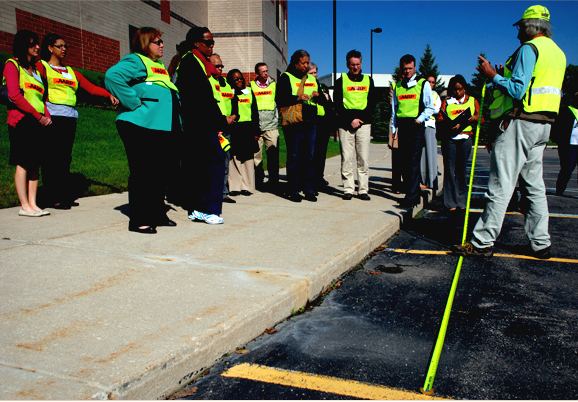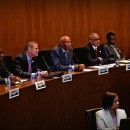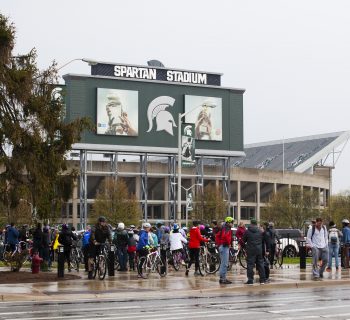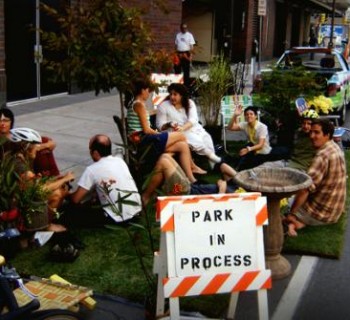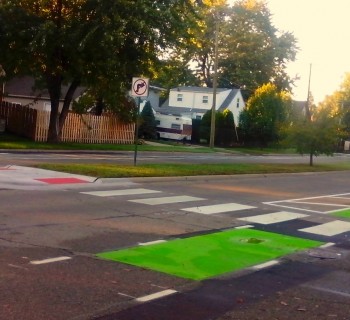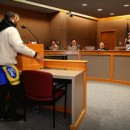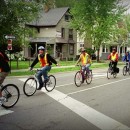DETROIT — A report recently issued from a September meeting may tell the Seven Mile-Telegraph Road area what it already knows: The wide, busy streets are a challenge for non-motorized transportation, transit choices are limited and other challenges exist to make the surrounding neighborhoods vibrant, healthy connected communities.
But the document’s main author, Dan Burden, executive director of the Walkable and Livable Communities Institute, says the meeting, conversation and research leading up to the report have value for the area, metro Detroit and communities across the country.
That’s because dealing with an aging infrastructure built for cars and trucks, evaluating future policies to improve neighborhoods, combining efforts with economic development strategies and creating communities that support healthier living should be a universal concern.
“It’s a very powerful tool,” he says. “The city and the funders should take a good look at all of that. All of us are interested in seeing Detroit turn around.”
Burden, based in Port Townsend, Wash., travels the country teaching communities how to better design walkable, bikable, healthy, connected communities that will help spur economic development, community pride and better overall health.
In September, he led the Activing Living Workshop at the behest of AARP and attended by a variety of local and state public health and transit advocates, representatives of groups supporting the elderly and city and regional planners.
Burden spoke with Mode Shift about the report and his observations of Detroit.
Mode Shift: Why was the Seven Mile-Telegraph area chosen for this workshop?
Dan Burden: The organizers wanted to make sure they picked an area that was having serious problems that could generate interest. The area was just typical of the problems we’re seeing. They wanted something that could become an example of models for what could be done elsewhere in Detroit. And it had ethnically rich and diverse neighborhoods.
MS: What are the particular design challenges of the Seven Mile-Telegraph stretch to making it a more pedestrian-friendly community?
DB: The challenge is the size, scale and speed of the roads. The combined two roads as they intersect are so wide that it just creates all kinds of ripple effects for anyone outside of a car. It lacks all the tools that could be used to make it a much better crossing. Its sheer size is like a river running through a community. It has more lanes than it needs, lacks good edges and is not being maintained at all. It has poor identification of the driveways, the strips centers are aged, the whole area is ready for totally new investment if there was a strategy to come together. It serves a huge population of people who drive long distances to get to other services.
MS: What are the particular infrastructure challenges for the area?
DB: The resistance. The Detroit Department of Transportation is buried in the past. They think that someday a city that was once 2.8 million and is now down to 700,000 will become a great city again. They have no awareness of how the economy is working against that, how the land use settlement patterns are going. That cat got out of the bag, and it’s going to be hard to chase down the cat. In fact, we don’t know which field the cat is in anymore. It’s unfortunate that so many people that get into transportation are not learning the new priorities, the new tools of what transportation needs to be in the future.
"I’d put MDOT in the top 10 nationally for being an agency that is trying new things like road diets, focusing politics and Complete Streets approaches."
MS: But Detroit has a new CEO of transportation, Rob Freeland, who comes from Maryland. Can he help?
DB: That’s good news. Anyone who came from Maryland should get the big picture.
MS: What about the rest of the state, outside of Detroit?
DB: I would have to say Michigan is my biggest client. We’re doing another seven projects this coming year for MDOT under the new governor. … For being a Midwestern state, Michigan is doing more for walkability just in sheer volumes and numbers.
MS: Is this renewed emphasis because of political leadership?
DB: It’s the economics of place. The new governor is very interested in jobs but based on his discussions about placemaking, I think he’s become informed on the role of placemaking on bringing jobs back to Michigan. I think there is a very concerted effort in a number of communities and that’s having a spillover effect.
MS: So the state is doing OK.
DB: I’d put MDOT in the top 10 nationally for being an agency that is trying new things like road diets, focusing politics and Complete Streets approaches. I would definitely list Michigan as a leader in state departments of transportation and in overall awareness of the importance of smart growth.
MS: For any of the improvements to happen, funding is needed. What have you seen happen in other places across the country?
DB: Most often they’re funded through local initiatives where the government puts up its share to do the public part or do the infrastructure par and then gets private developers to come in and build the new buildings and private centers.
Have ideas for improving the walkability of your communities that Dan missed? Share in the comments below!


